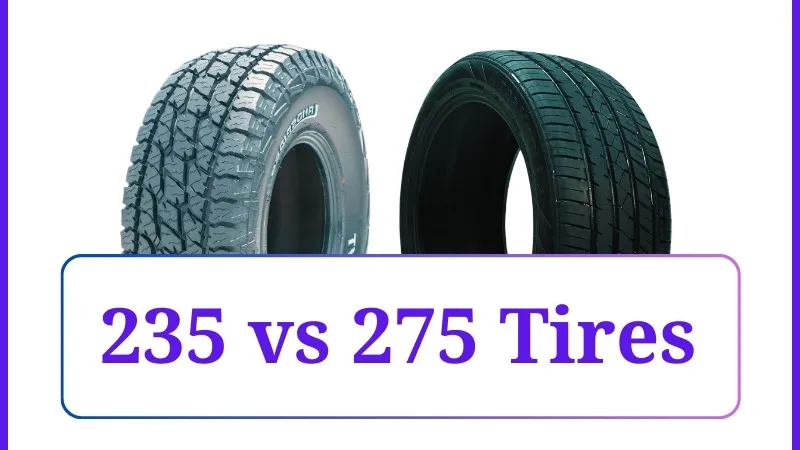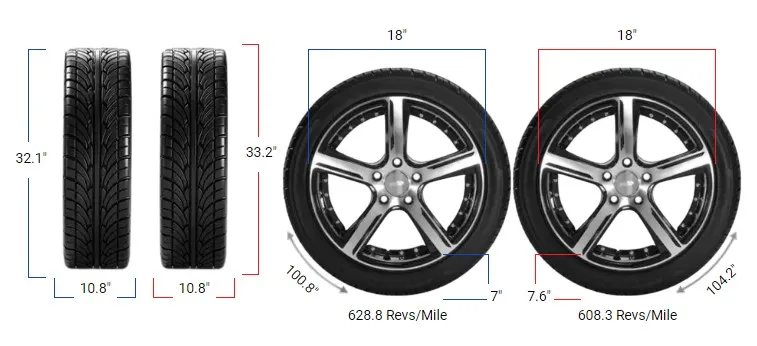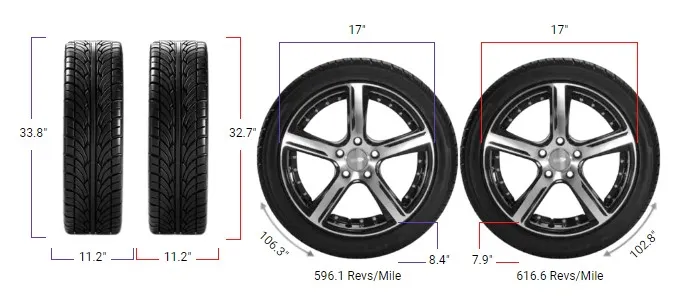235 vs 275 Tires

The key difference between 235 and 275 tires is their width. The 275 tires is about 40 mm wider than the 235 tires. A 235 tire has a width of 235 millimeters, while a 275 tire measures 275 millimeters wide.
This difference affects various factors such as traction, handling, fuel efficiency, and ride comfort. With 275 tires, you get a wider contact patch, which provides enhanced grip and stability, especially during high-speed driving and cornering.
This extra width is beneficial for vehicles that require improved traction and stability, such as trucks and SUVs. In contrast, 235 tires offer a balanced approach, providing adequate traction while maintaining better fuel efficiency and more nimble handling, making them suitable for everyday driving.
Fitment Guide
Before deciding between 235 and 275 tires, it is essential to understand their fitment requirements. Below is the Ideal Rim Width Range for each tire size:
- 235 tire: Suitable for rims that are 7.0 to 8.5 inches wide.
- 275 tire: Compatible with rims ranging from 9.0 to 10.5 inches wide.
In this case, there is no overlap between the rim width ranges for 235 and 275 tires, meaning a direct swap is not feasible without changing the rims.

On-Road Performance
The 275 tire offers improved handling and stability due to its wider contact patch, making it a great choice for drivers who need additional traction, especially during high-speed maneuvers or while towing heavy loads. The increased width provides better grip, enhancing cornering performance and stability on the road.
On the other hand, 235 tires provide a more agile and responsive driving experience, particularly in urban environments. The narrower profile reduces rolling resistance, resulting in lighter steering and improved maneuverability. For those who prioritize a nimble driving feel and ease of handling in tight spaces, 235 tires may be the preferred choice.
Fuel Efficiency: When it comes to fuel efficiency, 235 tires have the upper hand. The narrower profile reduces rolling resistance, meaning the vehicle requires less energy to maintain speed. This translates to better fuel economy, which is a significant advantage for drivers who frequently commute long distances or want to keep fuel costs low.
In contrast, 275 tires provide more grip and stability but come with increased rolling resistance, leading to higher fuel consumption. While the performance benefits are notable, it is important to weigh the increased fuel costs, especially if your primary focus is on efficiency.
Ride Comfort: 235 tires generally offer a smoother and quieter ride for everyday driving. The narrower width allows the tire to absorb minor road imperfections more effectively, resulting in reduced road noise and a comfortable ride, especially on well-maintained roads. This makes 235 tires an appealing choice for those who prioritize comfort.

275 tires, while providing better stability, tend to offer a firmer ride due to the increased contact area and stiffer sidewalls. This can lead to more noticeable road noise and a less forgiving ride over rough or uneven surfaces. However, for those who value stability and a sportier feel, 275 tires can provide a more confident driving experience.
Off-Road Performance
For drivers who frequently venture off-road, 275 tires are generally better suited to the task. The wider contact patch provides greater traction on loose surfaces like gravel, sand, and mud, improving stability and reducing the likelihood of getting stuck.
This makes 275 tires a popular choice for trucks and SUVs used for off-road adventures. 235 tires are capable of handling light off-road conditions but may struggle to maintain stability on loose or uneven surfaces compared to 275 tires.
The narrower profile limits the contact area, which can make traction more challenging in demanding off-road environments. However, 235 tires are still versatile enough for those who occasionally take their vehicles off the pavement.

Speedometer Impact
Switching between 235 and 275 tires can affect the accuracy of your vehicle’s speedometer and odometer. If the overall diameter changes significantly, it may cause discrepancies in speed and distance readings.
For instance, a larger overall diameter can lead to the speedometer underreporting your speed, while a smaller diameter can cause it to overreport.
To ensure accurate speed and distance readings, it may be necessary to recalibrate the speedometer if the overall diameter change exceeds 3%.
Proper calibration is essential for maintaining reliable performance metrics and adhering to speed limits.

Benefits of 275 Tires:
- Enhanced Traction and Stability: The wider contact area provides better grip, especially during high-speed driving and off-road conditions.
- Aggressive Appearance: 275 tires give vehicles a more rugged and commanding look, which can be appealing for those seeking a bold aesthetic.
- Improved Off-Road Capability: The increased footprint provides better flotation on loose surfaces, making 275 tires ideal for off-road adventures.
Drawbacks of 275 Tires:
- Lower Fuel Efficiency: The increased rolling resistance of 275 tires can lead to reduced fuel efficiency, particularly during city driving.
- Firmer Ride: The wider profile may contribute to a firmer ride, which can be less comfortable for those prioritizing a smooth driving experience.
Benefits of 235 Tires:
- Better Fuel Economy: The narrower width reduces rolling resistance, resulting in improved fuel efficiency, making 235 tires ideal for long commutes.
- Easier Handling: The lighter steering effort makes 235 tires easier to maneuver, particularly in urban environments.
- Quieter Ride: The reduced contact patch helps minimize road noise, contributing to a quieter and more comfortable driving experience.
Drawbacks of 235 Tires:
- Limited Traction: Compared to 275 tires, 235 tires have a smaller contact area, which can reduce traction, especially in wet or challenging conditions.
- Less Aggressive Appearance: 235 tires may not provide the same bold look as wider 275 tires, which can be important for those seeking a sportier aesthetic.

Difference Between 235 and 275 Tires
The main difference between 235 and 275 tires is their width: 235 mm versus 275 mm, making the 275 tire significantly wider. Their ideal rim width ranges do not overlap, indicating that a direct swap between these sizes is not compatible.
Can I Use 235 Tires Instead of 275?
No, using 235 tires instead of 275 is not recommended due to the lack of overlap in their ideal rim width ranges. This could lead to compromised performance, safety, and comfort.
Can I Use 275 Tires Instead of 235?
No, switching from 235 to 275 tires is not advisable since there is no overlap in their ideal rim width ranges. This mismatch may negatively impact vehicle handling and safety.
Can You Put 235 Tires on 275 Rims?
No, 235 tires cannot be mounted on rims designed for 275 tires because the ideal rim width ranges do not overlap. Using mismatched rims and tires could lead to unsafe driving conditions.
Can You Put 275 Tires on 235 Rims?
No, you cannot put 275 tires on rims originally intended for 235 tires due to the absence of overlap in their ideal rim width ranges. This incompatibility may compromise vehicle safety and handling.
Our Observation
The choice between 235 and 275 tires ultimately depends on your driving preferences and requirements. If you prioritize fuel efficiency, maneuverability, and a comfortable ride, 235 tires are likely the better option.
On the other hand, if you seek enhanced traction, stability, and a more aggressive look, 275 tires are worth considering.
Remember that a direct swap between these sizes is not feasible without changing the rims, as their Ideal Rim Width Ranges do not overlap.



